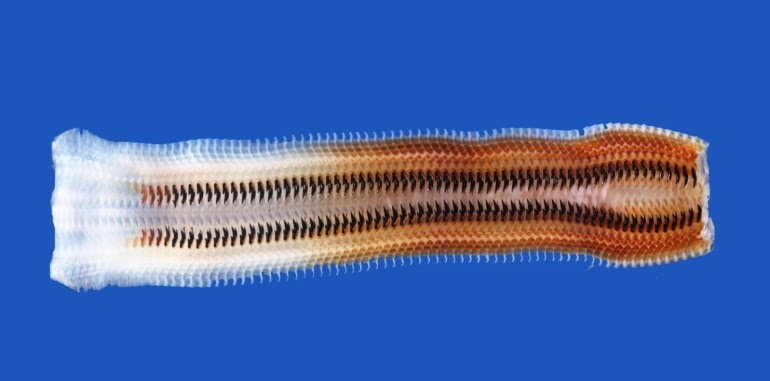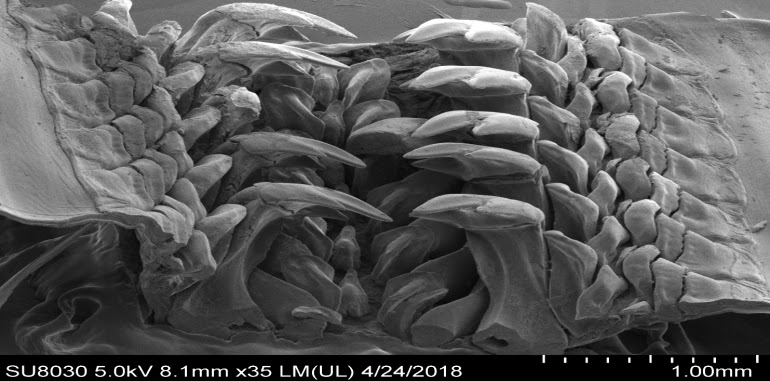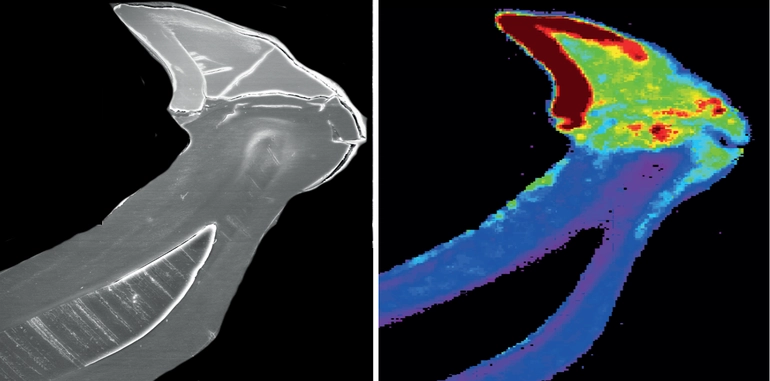A new study has found a rare mineral hidden inside the teeth of a chiton, a large mollusk found along rocky coastlines. Before this strange surprise, the iron mineral, called santabarbaraite, only had been documented in rocks.
According to the study, which was published in the Proceedings of the National Academy of Sciences, on May 31 last – This mineral has only been observed in geological specimens in very tiny amounts and has never before been seen in a biological context

|
| the entire radula showing all stages of development. Credit: Northwestern University |
Chiton
One of the hardest known materials in nature, chiton teeth are attached to a soft, flexible, tongue-like radula, which scrapes over rocks to collect algae and other food.
Having long studied chiton teeth, Joester an associate professor of materials science and engineering in Northwestern’s McCormick School of Engineering and his team most recently turned to Cryptochiton stelleri, a giant, reddish-brown chiton that is sometimes affectionately referred to as the “wandering meatloaf.”
The chiton have a shell made up of 8 separate plates or valves, and these plates overlap slightly at the front and rear edges, and the shell provides protection at the same time as allowing the chiton to flex upwards when needed to move on uneven surfaces, and even allow them to roll into a ball when expelled of rocks.
chiton live all over the world, from cold waters to the tropics on hard surfaces, for example above or under rocks or in their crevices.

|
| Scanning electron microscope image of the anterior end of the radula with mature teeth. Credit: Northwestern University |
Researchers have discovered a rare iron mineral known as Santabarbarite in the teeth of these rock-grazing mollusks, an amorphous ferric hydroxyphosphate mineral hydrate discovered in Tuscany, Italy in 2000.
The discovery sheds light on how this happens, and the researchers said chiton can scrape food off rocks, strengthening teeth without adding much weight.
To examine a tooth from Cryptochiton stelleri, Joester’s team collaborated with Ercan Alp, a senior scientist at Argonne National Laboratory’s Advanced Photon Source, to use the facility’s synchrotron Mössbauer spectroscopy as well as with Paul Smeets to use transmission electron microscopy at the Northwestern University Atomic and Nanoscale Characterization and Experiment (NUANCE) Center.
They found santabarbaraite dispersed throughout the chiton’s upper stylus, a long, hollow structure that connects the head of the tooth to the flexible radula membrane.
“The stylus is like the root of a human tooth, which connects the cusp of our tooth to our jaw,” Joester said. “It’s a tough material composed of extremely small nanoparticles in a fibrous matrix made of biomacromolecules, similar to bones in our body.”

|
| Distribution of iron and phosphorous in the major lateral teeth of C. stelleri |
biomineralization
Biomineralization is the process by which organisms often produce minerals for hardening of tissues called “tissue mineralization”; It is a very common phenomenon in all taxonomic kingdoms, and more than 60 different minerals have been identified in living organisms.
Organisms mineralized skeletons from 550 million years ago, examples include silicates in algae and diatoms, carbonates in invertebrates and calcium phosphates and carbonates in vertebrates.
These minerals often form structural features such as seashells and bone in mammals and birds. Other examples include copper, iron and gold in sediments that contain bacteria.
The most common bio-minerals are the phosphates and carbonate of calcium salts that are used with organic polymers such as collagen and chitin to provide structural support to bones and shells.
The structures of these biocomposites are highly controlled, resulting in complex structures that provide multifunctional properties, and because this range of metal growth control is desirable for materials engineering applications, there is great interest in understanding and elucidating the mechanisms of biologically controlled biomineralization.
Joester believes we can continue to learn from and develop materials inspired by the chiton’s stylus, which connects ultra-hard teeth to a soft radula.
Sources:
- https://www.pnas.org/content/118/23/e
- https://news.northwestern.edu/stories/2021/05/rare-mineral-from-rocks-found-in-chiton-teeth/&fj=1

